Life Cycle Assessment of Adjustable Permanent Magnet Drives for a Low-Carbon Transition in China’s Coal-Fired Power Systems
Abstract
1. Introduction
2. Methodology
2.1. Boundary and Functional Unit
- Upstream processes: Resource extraction (rare earth, copper, and steel) and material production.
- Manufacturing: Component fabrication (permanent magnet rotors and winding stators) and assembly.
- Use phase: 30-year operational energy consumption and maintenance.
- End of life: Disassembly, material recycling, and waste treatment.
- Material/energy flows of primary materials (NdFeB magnets and copper windings)
- Emission vectors from key industrial processes
- Slip-power recovery during operation
- Material recycling contributions
2.2. Data Collection and Inventory Analysis
2.3. Method of LCIA
2.4. Scenario Settings
- (1)
- High-potential group:
- Capacity [300, 500) MW: 2 × 1.25 MW APMDs
- Capacity [500, 800) MW: 4 × APMDs
- Capacity ≥ 800 MW: 6 × APMDs
- (2)
- Moderate-potential group:
- Capacity [300, 500) MW: 1 × APMDs
- Capacity [500, 800) MW: 3 × APMDs
- Capacity ≥ 800 MW: 5 × APMDs
- (3)
- Low-potential group:
- Capacity ≥ 200 MW: 1 × APMDs
- Capacity < 200 MW: Deemed to have no retrofitting value.
3. Results
3.1. Life Cycle Environmental Impacts
- GWP: 95% reduction in cumulative emissions (29.7 vs. 570 t CO2_eq)
- PMFP: 19.3% reduction (3.42 vs. 4.24 kg PM_eq)
- FDP: 22.1% decrease (1820 vs. 2335 kg oil_eq)
- POFP: 17.8% decrease (9.7 vs. 11.8 kg NOX_eq)
- AP: 14.6% decrease (12.3 vs. 14.4 kg SO2_eq)
3.2. Comparison of Carbon Footprints
3.3. Sensitivity Analysis
3.4. Scenario Analysis
4. Discussion
4.1. Environmental Benefit Mechanism and System Advantages of APMDs
4.2. Key Constraints in Technology Promotion
4.3. Renovation Path and Potential for Reducing the Emissions of Coal-Fired Power Systems
4.4. Research Limitations and Future Directions
5. Conclusions
Author Contributions
Funding
Institutional Review Board Statement
Informed Consent Statement
Data Availability Statement
Acknowledgments
Conflicts of Interest
References
- IEA. Energy Efficiency Policy Opportunities for Electric Motor-Driven Systems. 2011. Available online: https://www.iea.org/reports/energy-efficiency-policy-opportunities-for-electric-motor-driven-systems (accessed on 15 September 2025).
- Oliveira, F.; Ukil, A. Comparative Performance Analysis of Induction and Synchronous Reluctance Motors in Chiller Systems for Energy Efficient Buildings. IEEE Trans. Ind. Inf. 2019, 15, 4384–4393. [Google Scholar] [CrossRef]
- Kapp, S.; Wang, C.; McNelly, M.; Romeiko, X.; Choi, J.-K. A comprehensive analysis of the energy, economic, and environmental impacts of industrial variable frequency drives. J. Clean. Prod. 2024, 434, 140474. [Google Scholar] [CrossRef]
- Lavrič, H.; Drobnič, K.; Fišer, R. Model-Based Assessment of Energy Efficiency in Industrial Pump Systems: A Case Study Approach. Appl. Sci. 2024, 14, 10430. [Google Scholar] [CrossRef]
- Creamer, J.; Van Hemert, G. Energy savings—VFDs and more. World Pumps 2010, 2010, 24–28. [Google Scholar] [CrossRef]
- Abdelaziz, E.A.; Saidur, R.; Mekhilef, S. A review on energy saving strategies in industrial sector. Renew. Sustain. Energy Rev. 2011, 15, 150–168. [Google Scholar] [CrossRef]
- Yan, X.; Chen, B. Analysis of a novel energy-efficient system with a bidirectional supercharger for forging hydraulic press. J. Clean. Prod. 2021, 286, 125520. [Google Scholar] [CrossRef]
- Li, H.; Liu, J.; Li, K.; Liu, Y. A review of recent studies on piezoelectric pumps and their applications. Mech. Syst. Sig. Process. 2021, 151, 107393. [Google Scholar] [CrossRef]
- De Almeida, A.; Fong, J.; Brunner, C.U.; Werle, R.; Van Werkhoven, M. New technology trends and policy needs in energy efficient motor systems—A major opportunity for energy and carbon savings. Renew. Sustain. Energy Rev. 2019, 115, 109384. [Google Scholar] [CrossRef]
- Arun Shankar, V.K.; Umashankar, S.; Paramasivam, S.; Hanigovszki, N. A comprehensive review on energy efficiency enhancement initiatives in centrifugal pumping system. Appl. Energy 2016, 181, 495–513. [Google Scholar] [CrossRef]
- O’Brien, M. Reducing Industrial CO2 Emissions Through Increased Motion Efficiency; Analog Devices, Inc.: Wilmington, DC, USA, 2023. [Google Scholar]
- IEA. Electricity Market Report 2023. Available online: https://www.iea.org/reports/electricity-market-report-2023 (accessed on 12 September 2025).
- Eichhammer, W.; Fleiter, T. Energy Efficiency in Electric Motor Systems: Technology, Saving Potentials and Policy Options for Developing Countries; UNIDO: Vienna, Austria, 2012. [Google Scholar]
- An, Q.; Lu, Y.; Zhao, M. Review of Key Technologies of the High-Speed Permanent Magnet Motor Drive. Energies 2024, 17, 5252. [Google Scholar] [CrossRef]
- IEEE Std 519-2022 (Revision of IEEE Std 519-2014); IEEE Standard for Harmonic Control in Electric Power Systems. IEEE: New York, NY, USA, 2022; pp. 1–31.
- Siemens. Cost Considerations When Selecting Variable Frequency Drive Solutio. 2017. Available online: https://d3mm496e6885mw.cloudfront.net/manufacturer_product/5919d9d2e4b0b6f46aff2a4b/project/projects/original/Cost_Considerations_VFD_FINAL.pdf (accessed on 10 September 2025).
- Precision Electric, Inc. ABB VFD: A Comprehensive Guide to Variable Frequency Drives; Precision Electric, Inc.: Mishawaka, IN, USA, 2022. [Google Scholar]
- Hughes, A.; Drury, B. Chapter 9—Synchronous, permanent magnet and reluctance motors and drives. In Electric Motors and Drives, 5th ed.; Hughes, A., Drury, B., Eds.; Newnes: Oxford, UK, 2019; pp. 307–373. [Google Scholar]
- Ormerod, J. Chapter 12—Permanent magnet markets and applications. In Modern Permanent Magnets; Croat, J., Ormerod, J., Eds.; Woodhead Publishing: Cambridge, MA, USA, 2022; pp. 403–434. [Google Scholar]
- de Almeida, A.T.; Fong, J.; Falkner, H.; Bertoldi, P. Policy options to promote energy efficient electric motors and drives in the EU. Renew. Sustain. Energy Rev. 2017, 74, 1275–1286. [Google Scholar] [CrossRef]
- Hughes, A.; Drury, B. Chapter Nine—Synchronous and Brushless Permanent Magnet Machines and Drives. In Electric Motors and Drives, 4th ed.; Hughes, A., Drury, B., Eds.; Newnes: Boston, MA, USA, 2013; pp. 281–313. [Google Scholar]
- Baldassarre, B.; Carrara, S. Critical raw materials, circular economy, sustainable development: EU policy reflections for future research and innovation. Resour. Conserv. Recycl. 2025, 215, 108060. [Google Scholar] [CrossRef]
- Kumari, A.; Sahu, S.K. A comprehensive review on recycling of critical raw materials from spent neodymium iron boron (NdFeB) magnet. Sep. Purif. Technol. 2023, 317, 123527. [Google Scholar] [CrossRef]
- GB 30253-2024; Minimum Allowable Values of Energy Efficiency and Energy Efficiency Grades for Permanent Magnet Synchronous Motors. State Administration for Market Regulation: Beijing, China, 2024.
- Ministry of Industry and Information Technology, PRC. National Directory of Energy-Saving and Carbon Reduction Technology and Equipment for the Industrial and Information Technology Sectors. 2025. Available online: https://www.miit.gov.cn/zwgk/zcwj/wjfb/gg/art/2024/art_28ce8b3d62454e05a2da551cfc1412e8.html (accessed on 7 October 2025).
- Congress, USA. H.R.5376—Inflation Reduction Act of 2022. In Proceedings of the 117th Congress (2021–2022), Washington, DC, USA, 8–27 April 2022. [Google Scholar]
- Kaya, M. An overview of NdFeB magnets recycling technologies. Curr. Opin. Green Sustain. Chem. 2024, 46, 100884. [Google Scholar] [CrossRef]
- Schulze, R.; Buchert, M. Estimates of global REE recycling potentials from NdFeB magnet material. Resour. Conserv. Recycl. 2016, 113, 12–27. [Google Scholar] [CrossRef]
- Koenen, C.; Reuss, H.C. Sustainability optimization of the NdFeB magnet system of PMSMs by linking electromagnetic calculation and life cycle assessment. In Proceedings of the Elektromechanische Antriebssysteme 2023; 9. Fachtagung (VDE OVE), Wien, Austria, 8–9 November 2023; pp. 31–37. [Google Scholar]
- Li, Z.; Che, S.; Zhao, H.; Zhang, L.; Wang, P.; Du, S.; Zhang, H.; Feng, Y.; Sun, H. Loss analysis of high-speed permanent magnet motor based on energy saving and emission reduction. Energy Rep. 2023, 9, 2379–2394. [Google Scholar] [CrossRef]
- Auer, J.; Meincke, A. Comparative life cycle assessment of electric motors with different efficiency classes: A deep dive into the trade-offs between the life cycle stages in ecodesign context. Int. J. Life Cycle Assess. 2018, 23, 1590–1608. [Google Scholar] [CrossRef]
- Jung, S.-W.; Kang, D.; Palanimuthu, K.; Joo, Y.H.; Jung, S.-Y. Design of 20 MW direct-drive permanent magnet synchronous generators for wind turbines based on constrained many-objective optimization. Wind Energy 2024, 27, 847–872. [Google Scholar] [CrossRef]
- Wardach, M.; Palka, R.; Prajzendanc, P.; Gundabattini, E.; Cierzniewski, K.; Pstrokonski, R.; Cichowicz, M.; Wiszniewski, M.; Pacholski, S.; Singh Rassiah, R.; et al. Permanent magnet assisted synchronous reluctance machine for drives of light vehicles. Sustain. Energy Technol. Assess. 2024, 65, 103780. [Google Scholar] [CrossRef]
- Zhao, X.; Zhou, Y.; Song, Y.; Xu, J.; Li, J.; Tat, T.; Chen, G.; Li, S.; Chen, J. Permanent fluidic magnets for liquid bioelectronics. Nat. Mater. 2024, 23, 703–710. [Google Scholar] [CrossRef]
- National Bureau of Statistics, PRC. Statistical Bulletin of the National Economic and Social Development of the People’s Republic of China for the Year, 2024. Available online: https://www.stats.gov.cn/sj/zxfb/202502/t20250228_1958817.html (accessed on 12 October 2025).
- Kao, X.; Liu, Y.; Wang, W.; Wen, Q.; Zhang, P. The pressure of coal consumption on China’s carbon dioxide emissions: A spatial and temporal perspective. Atmos. Pollut. Res. 2024, 15, 102188. [Google Scholar] [CrossRef]
- Mandi, R.P.; Yaragatti, U.R. Control of CO2 emission through enhancing energy efficiency of auxiliary power equipment in thermal power plant. Int. J. Electr. Power Energy Syst. 2014, 62, 744–752. [Google Scholar] [CrossRef]
- Shajahan, M.S.M.; Jamal, D.N.; Mathew, J.; Ali Akbar, A.A.; Sivakumar, A.; Shahul Hameed, M.S. Improvement in efficiency of thermal power plant using optimization and robust controller. Case Stud. Therm. Eng. 2022, 33, 101891. [Google Scholar] [CrossRef]
- Wang, R.; Cai, W.; Cui, R.Y.; Huang, L.; Ma, W.; Qi, B.; Zhang, J.; Bian, J.; Li, H.; Zhang, S.; et al. Reducing transition costs towards carbon neutrality of China’s coal power plants. Nat. Commun. 2025, 16, 241. [Google Scholar] [CrossRef] [PubMed]
- Su, C.; Xu, Z.; Wang, X.; Li, B. Research on the Co-Evolution Mechanism of Electricity Market Entities Enabled by Shared Energy Storage: A Tripartite Game Perspective Incorporating Dynamic Incentives/Penalties and Stochastic Disturbances. Sustainability 2025, 13, 817. [Google Scholar] [CrossRef]
- Kuru, H. A Carbon Footprint Study of Electric Motor Production Using Life Cycle Assessment and Greenhouse Gas Protocol; LUT University: Lappeenranta, Finland, 2024. [Google Scholar]
- Johansson, S.S.E.; Isberg, P.J.; Westberg, E. Sustainability in the life of an electric motor: A circular future. ABB Rev. 2023, 1, 56–61. Available online: https://library.e.abb.com/public/5ea2f58712a546188d17f51424a87b6c/56-61+ABB+Review+Special+Edition+-+Women+in+STEM+2024+A+circular+future.pdf?x-sign=byF%2FkmResPlSOnpYrbqe7uadID74GX8FmcYXfdh0z8sbFfSFXNR8mLmx2hbmy34%2F (accessed on 15 October 2025).
- Li, H.; Huang, W.; Xu, J.; Huang, Q. Application of wound permanent magnet coupling speed regulator in speed regulation and energy saving. High-Technol. Commer. 2017, 42–45. Available online: https://qikan.cqvip.com/Qikan/Article/Detail?id=71757067504849554850484952 (accessed on 17 October 2025).
- ISO 14067:2018; Greenhouse Gases—Carbon Footprint of Products—Requirements and Guidelines for Quantification. International Organization for Standardization (ISO): Geneva, Switzerland, 2018.
- Orlova, S.; Rassõlkin, A. Permanent Magnets in Sustainable Energy: Comparative Life Cycle Analysis. Energies 2024, 17, 6384. [Google Scholar] [CrossRef]
- Li, J.; Zhang, Y.; Tian, Y.; Cheng, W.; Yang, J.; Xu, D.; Wang, Y.; Xie, K.; Ku, A.Y. Reduction of carbon emissions from China’s coal-fired power industry: Insights from the province-level data. J. Clean. Prod. 2020, 242, 118518. [Google Scholar] [CrossRef]
- Gündoğdu, T.; Kömürgöz, G. Technological and economical analysis of salient pole and permanent magnet synchronous machines designed for wind turbines. J. Magn. Magn. Mater. 2012, 324, 2679–2686. [Google Scholar] [CrossRef]
- Li, Z.; Che, S.; Wang, P.; Du, S.; Zhao, Y.; Sun, H.; Li, Y. Implementation and analysis of remanufacturing large-scale asynchronous motor to permanent magnet motor under circular economy conditions. J. Clean. Prod. 2021, 294, 126233. [Google Scholar] [CrossRef]
- Adibi, N.; Lafhaj, Z.; Payet, J. New resource assessment characterization factors for rare earth elements: Applied in NdFeB permanent magnet case study. Int. J. Life Cycle Assess. 2019, 24, 712–724. [Google Scholar] [CrossRef]
- Hernandez, M.; Messagie, M.; De Gennaro, M.; Van Mierlo, J. Resource depletion in an electric vehicle powertrain using different LCA impact methods. Resour. Conserv. Recycl. 2017, 120, 119–130. [Google Scholar] [CrossRef]
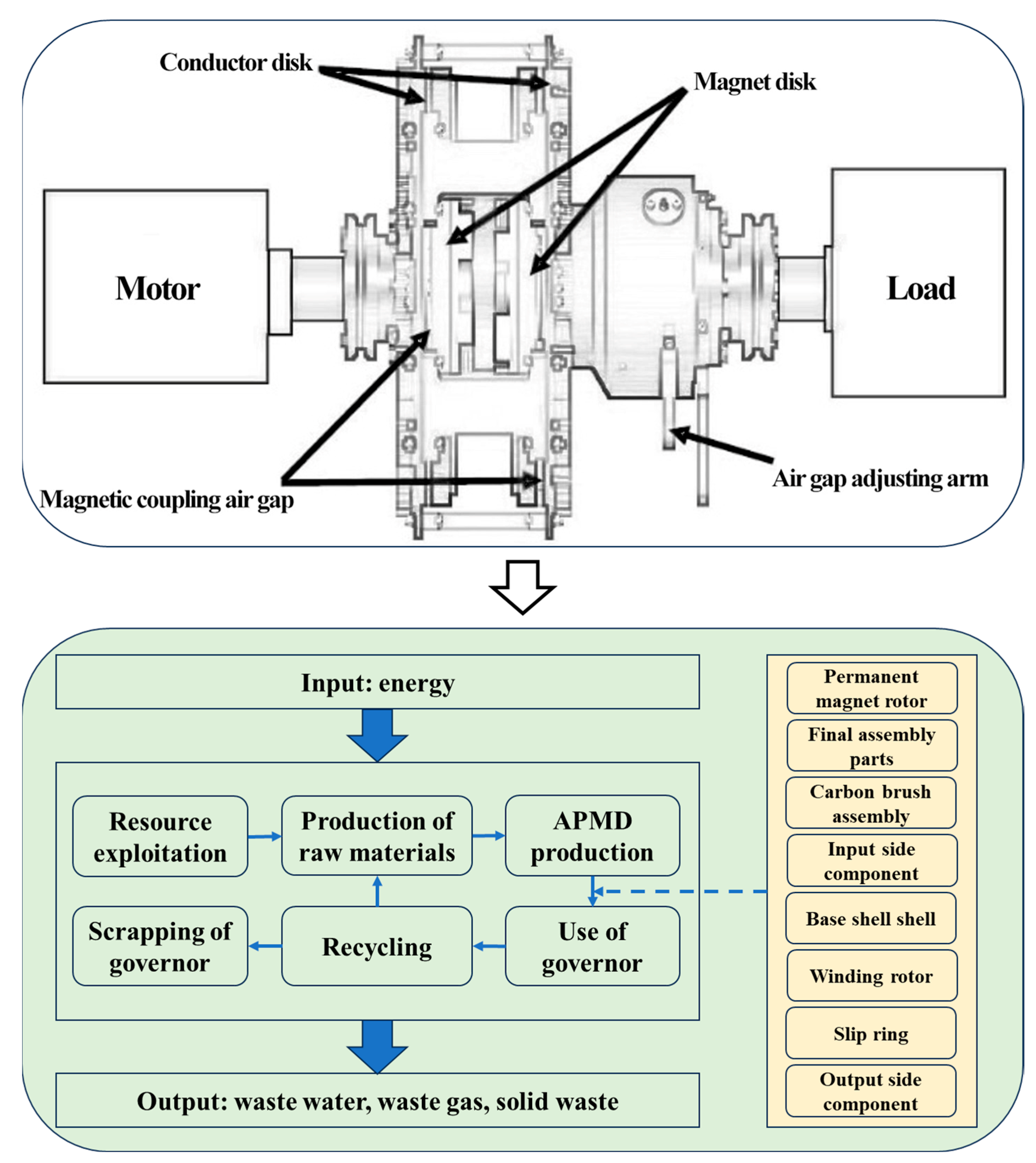
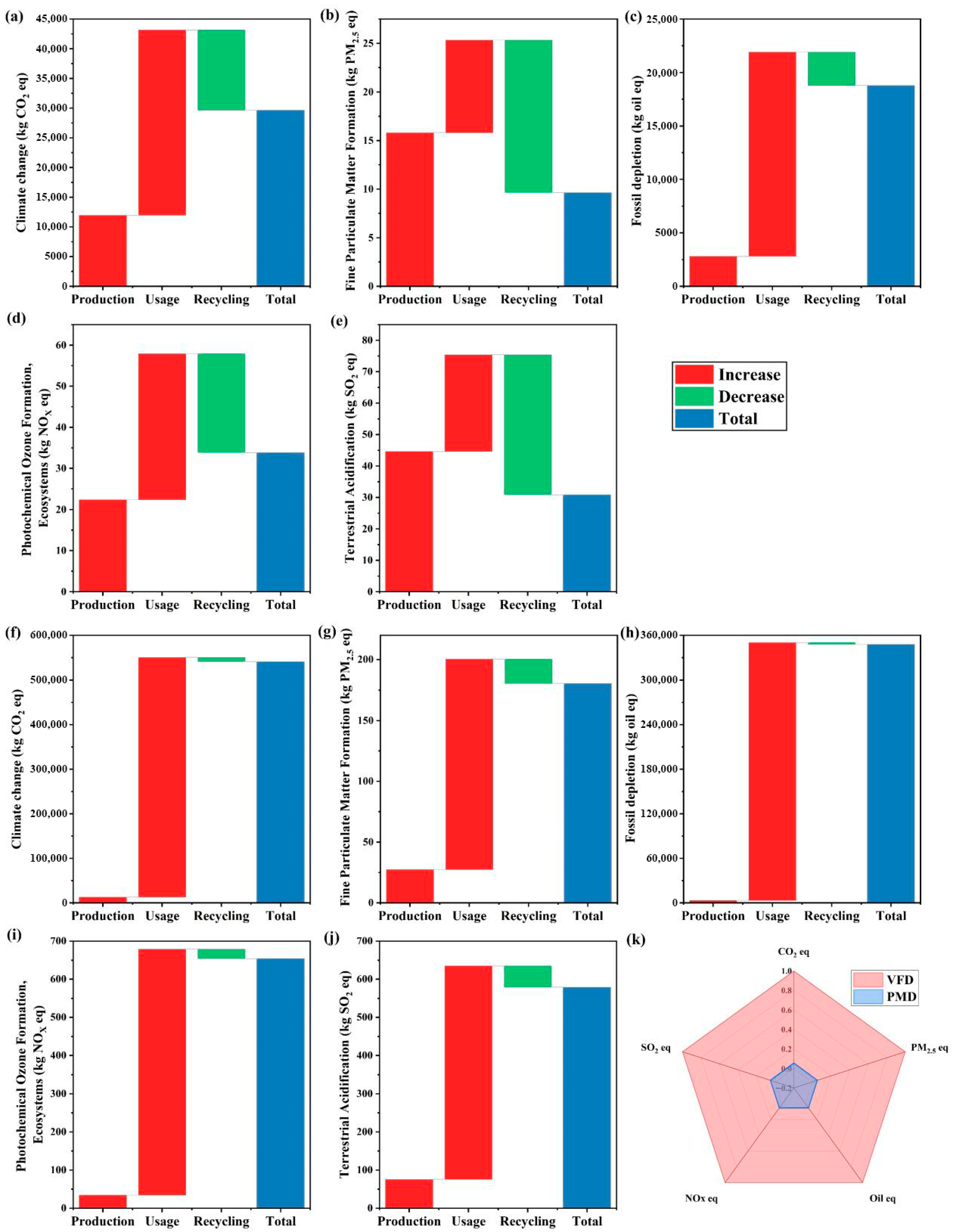
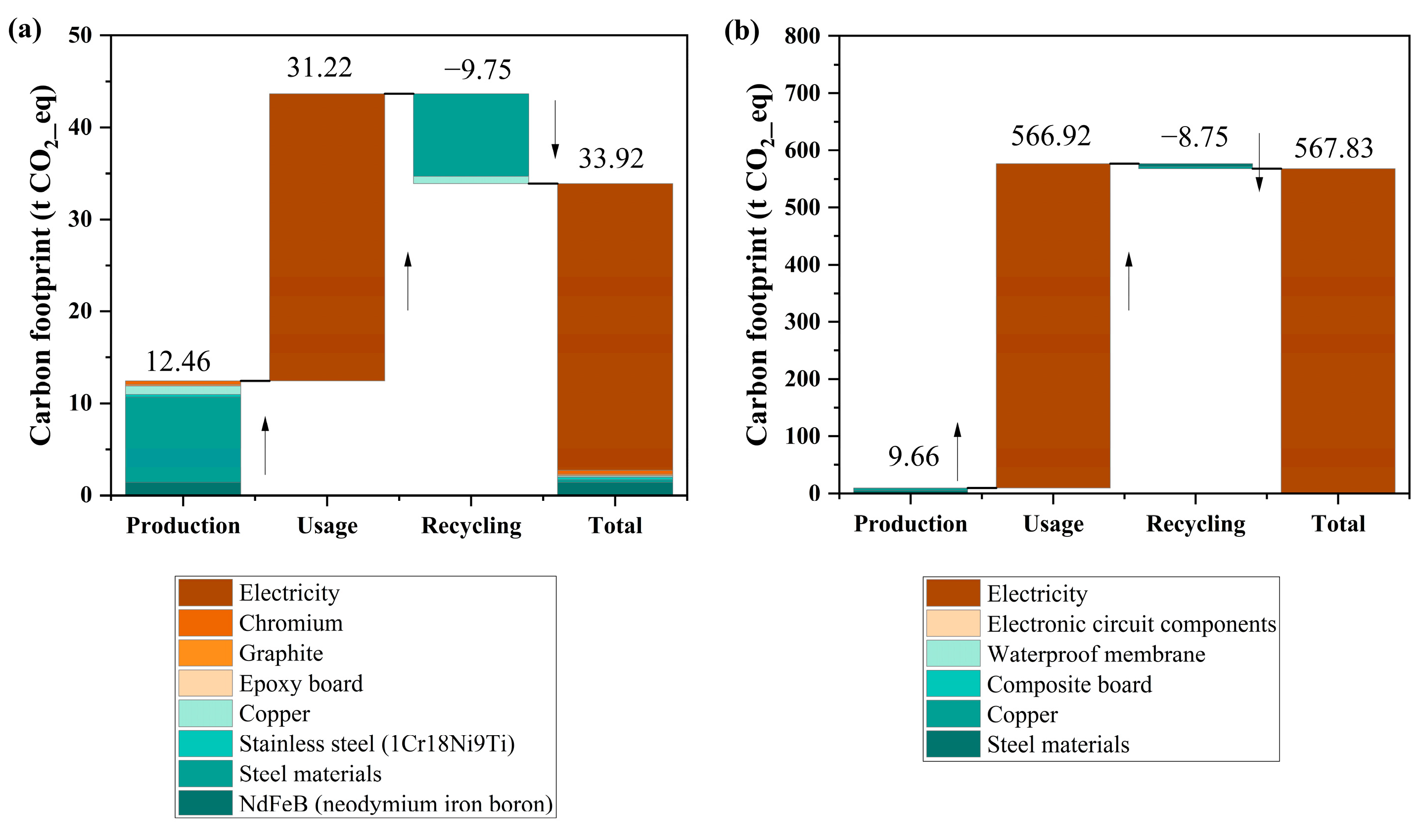
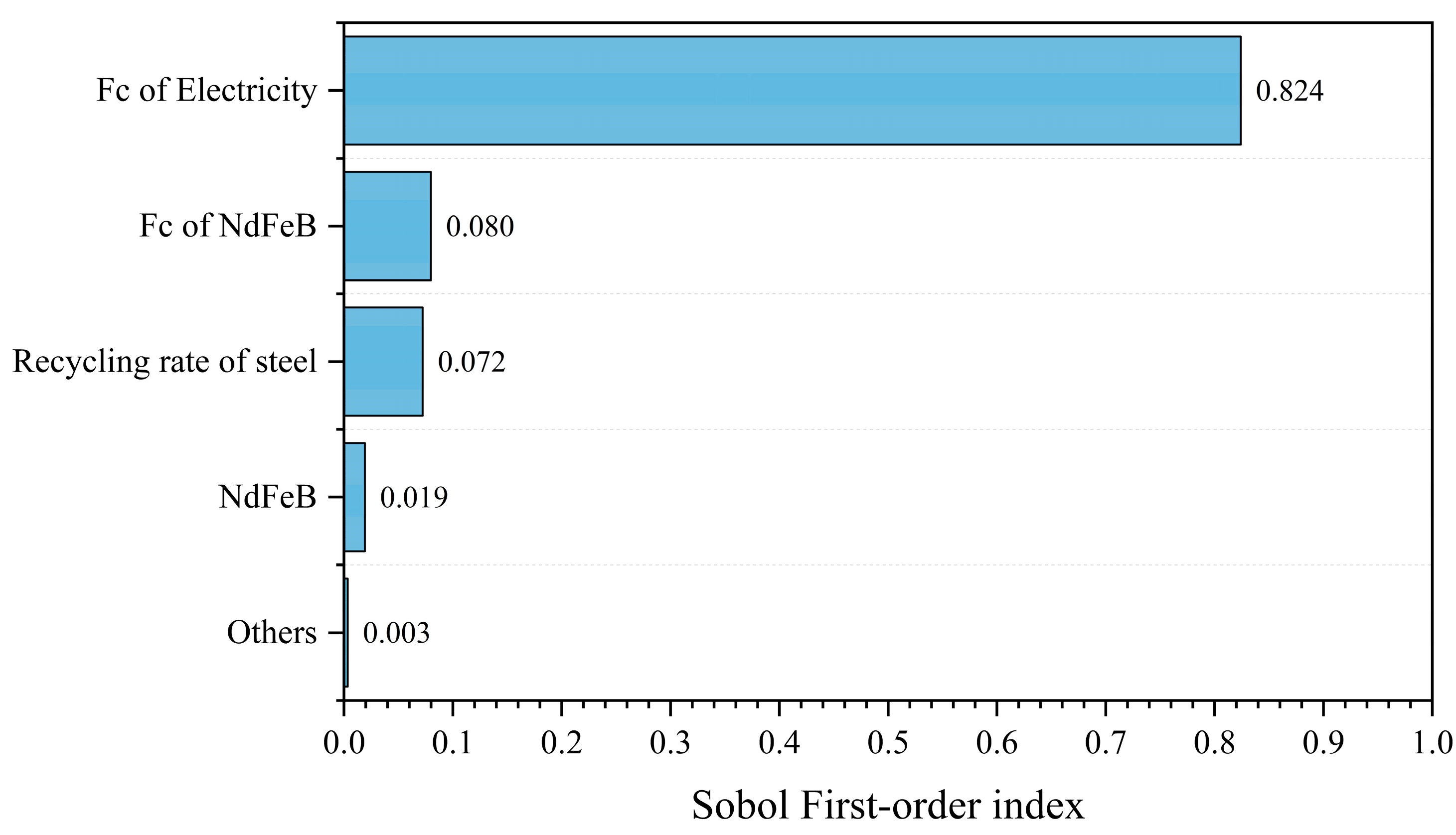
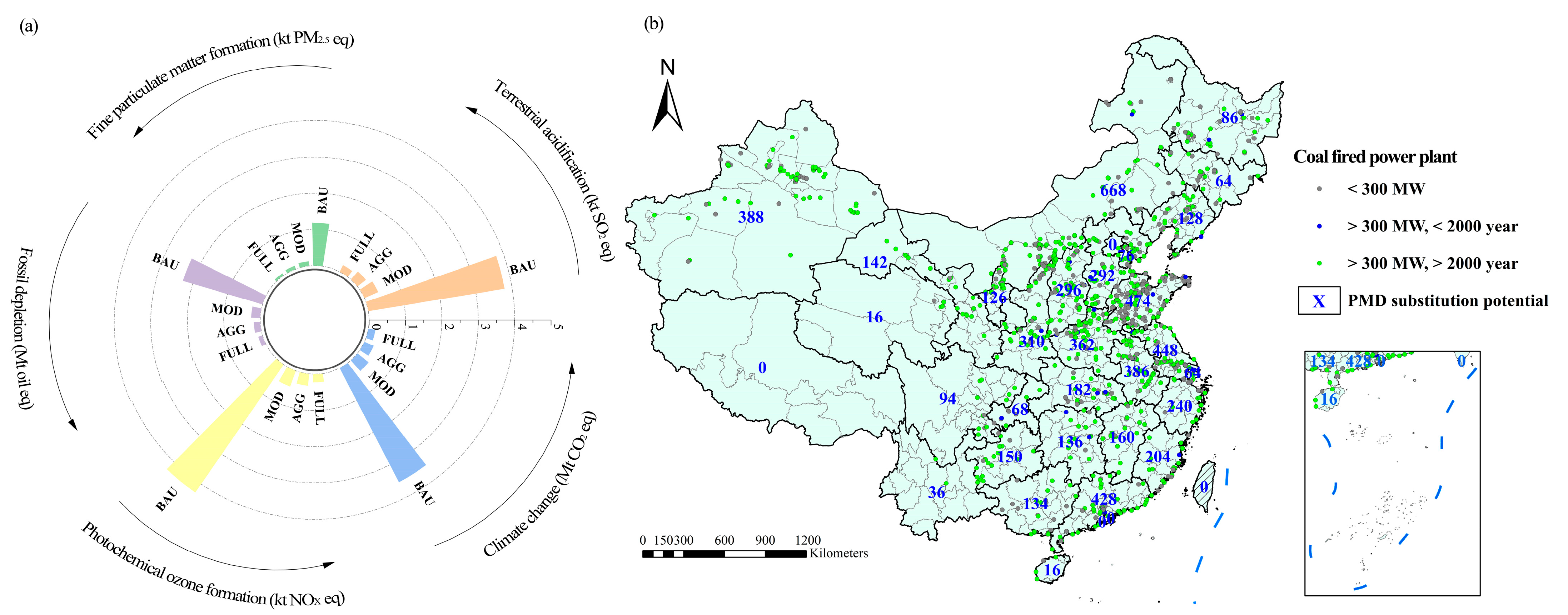
| Drive | Stage | Input | Amount | Unit |
|---|---|---|---|---|
| APMDs | Production | NdFeB (neodymium iron boron) | 72 | kg |
| Steel materials | 4616 | kg | ||
| Stainless steel (1Cr18Ni9Ti) | 54 | kg | ||
| Copper (Cu) | 265 | kg | ||
| Epoxy board (3240) | 6.3 | kg | ||
| Graphite | 18 | kg | ||
| Chromium (Cr) | 168 | kg | ||
| Usage | Electricity | 169.8 | MWh | |
| Recycling * | Steel | 3532.1 | kg | |
| Copper | 251.75 | kg | ||
| VFDs | Production | Steel | 2750 | kg |
| Copper | 1060 | kg | ||
| Composite board | 30 | kg | ||
| Waterproof membrane | 7.5 | kg | ||
| Electronic circuit components | 63 | kg | ||
| Usage | Electricity | 3087 | MWh | |
| Recycling | Steel materials | 2612.5 | kg | |
| Copper (Cu) | 1007 | kg |
Disclaimer/Publisher’s Note: The statements, opinions and data contained in all publications are solely those of the individual author(s) and contributor(s) and not of MDPI and/or the editor(s). MDPI and/or the editor(s) disclaim responsibility for any injury to people or property resulting from any ideas, methods, instructions or products referred to in the content. |
© 2025 by the authors. Licensee MDPI, Basel, Switzerland. This article is an open access article distributed under the terms and conditions of the Creative Commons Attribution (CC BY) license (https://creativecommons.org/licenses/by/4.0/).
Share and Cite
Zeng, Y.; Pan, J.; Gao, M.; Liang, D.; Zhuo, R.; Zhou, C.; Lu, B. Life Cycle Assessment of Adjustable Permanent Magnet Drives for a Low-Carbon Transition in China’s Coal-Fired Power Systems. Sustainability 2025, 17, 9574. https://doi.org/10.3390/su17219574
Zeng Y, Pan J, Gao M, Liang D, Zhuo R, Zhou C, Lu B. Life Cycle Assessment of Adjustable Permanent Magnet Drives for a Low-Carbon Transition in China’s Coal-Fired Power Systems. Sustainability. 2025; 17(21):9574. https://doi.org/10.3390/su17219574
Chicago/Turabian StyleZeng, Yutang, Jingjin Pan, Meng Gao, Dong Liang, Ran Zhuo, Chuanbin Zhou, and Bin Lu. 2025. "Life Cycle Assessment of Adjustable Permanent Magnet Drives for a Low-Carbon Transition in China’s Coal-Fired Power Systems" Sustainability 17, no. 21: 9574. https://doi.org/10.3390/su17219574
APA StyleZeng, Y., Pan, J., Gao, M., Liang, D., Zhuo, R., Zhou, C., & Lu, B. (2025). Life Cycle Assessment of Adjustable Permanent Magnet Drives for a Low-Carbon Transition in China’s Coal-Fired Power Systems. Sustainability, 17(21), 9574. https://doi.org/10.3390/su17219574





